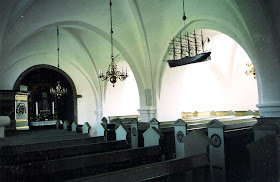
Uggerby Church

Interior
The church in Uggerby has a Romanesque choir with a modern addition: a side nave to the south and a tower to the west. The Romanesque building, the choir and nave, are built in granite ashlars. The straight-edged north door is preserved walled-in, and in the wall of the choir is seen a bricked-up round arched window with a monolit cover stone. A tower which probably was late Gothic was demolished in the 1820s.The building was thoroughly rebuilt and extended in 1923-25.The south wall of the nave was broken down, and a side nave was built in bricks and old ashlars, outside shaped like three chapels, each with a pointed gable, and to the west was added a tower with a gable roof. Inside was placed crossvaults and in the choir a false apse.
A Romanesque communion table in granite ashlars with a reliquary in the plate. The altar piece has a few joinery sections in Renaissance from ab. 1625 and a painting from 1885. A Romanesque granite font. A south German baptismal bowl from ab. 1575. Newer and simple pulpit. Pews from 1925. The old, very interesting church bell from 1473, inaugurated to St. Olav and with several reliefs was re-cast in 1917 by the Smithske Støberier in Aalborg with a repetition of the old ornaments.

Uggerby Å
Names from the Middle Ages and the 1600s:
Uggerby (1408 Wigherby, 1486 Wgherbii); Tolstrup (1484 Tolstrop); Skeen (1638 Scheen); Stabæk (Stathebæk); Uggerhøj (1638 Ugerhøy).
There are no listed prehistorics in the parish , but there were 2 hills and one long hill. North east of Uggerby is a settlement from early Stone Age. Findings of many knusesten (crushing stones ) south and west of Uggerby suggests that there was an Iron Age settlement. Early Roman period's graves are known from Uggerby and Østeråen.
Source: Trap Danmark, Hjørring amt, 1960.

photo Uggerby 2004: grethe bachmann
No comments:
Post a Comment
Thank you for visiting my blog!